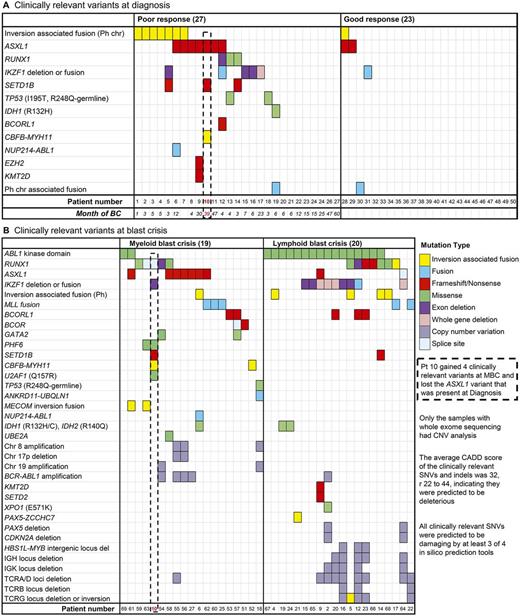Abstract
Background: Identification of CML patients (pts) destined for very poor outcome with standard therapy may guide investigational studies of novel therapies in high risk pts. Although a single genomic event is sufficient to cause CML, additional lesions are required for TKI resistance and disease progression. We hypothesized that additional genomic lesions are present at diagnosis (Dx) that modify response in poor outcome pts.
Aims: To determine if pts destined for poor response to TKI therapy harbor variants at Dx that may cooperate with BCR-ABL1 to influence outcome, and to uncover the somatic mutations that underlie disease transformation.
Method: Next generation sequencing was performed for 69 pts. Cohort 1 comprised 146 samples from 37 pts, including matched germline (mesenchymal stromal cells or remission), Dx, and/or blast crisis (BC, 20 pts). Dx samples were from chronic phase pts treated with first-line TKI: 14 good response (MMR by 3 mo) vs 15 poor response (BC, median 6 mo). Whole exome sequencing of germline/Dx/BC DNA, incorporating copy number variation (CNV) analysis was performed for all pts of Cohort 1, and RNAseq (Dx/BC) for 32 pts with available RNA. Cohort 2 comprised 40 samples (21 Dx and 19 BC) of pts with similar phenotype to Cohort 1 but only RNA was available for RNAseq to detect single nucleotide variants (SNVs), insertions/deletions (indels) and fusions. SNVs/indels, fusions and CNVs were validated by Sanger Sequencing and CytoScan high density arrays. Deleterious variants were classified as clinically relevant if they occurred in genes causally implicated in hematologic malignancy (COSMIC Cancer Gene Census); in genes recurrently mutated in our cohort; and known or novel somatic fusions and CNVs.
Results: In Cohort 1 at Dx, clinically relevant SNVs/indels and/or fusions were detected in 3/14 (21%) good response vs 9/15 (60%) poor response pts, P=.035. In Cohort 2 at Dx, clinically relevant variants were detected in 1/9 (11%) good vs 9/12 (75%) poor response pts, P=.004. Mutated genes detected in both cohorts at Dx were the known cancer genes ASXL1, IKZF1, RUNX1 and TP53, plus a novel recurrently mutated gene the histone methyltransferase SETD1B, Figure A. At Dx, 8 pts had novel inversion associated fusions of genes/sequences on the chromosome arms involved in the Ph translocation. BCR was the most frequent fusion partner associated with the inversions. One other pt that was only tested at BC had novel inversion associated fusions involving BCR and ABL1 . Interestingly, 8/9 pts with these Ph associated inversions had BC by 12 months (7) or failed 4 TKIs (1).
At BC clinically relevant SNVs/indels and/or fusions were detected in 20/20 pts in Cohort 1 and 19/19 pts in Cohort 2 (only RNAseq performed). Overall, 90% of pts at BC had clinically relevant SNVs/indels and 79% had fusions. The maximum number of clinically relevant variants at BC was 6, pt 10 Figure B, and 2 of these were present at Dx, Figure A. The diversity of mutations at BC suggests that several mutations contribute to progression in individual pts. The most frequently detected variants were ABL1 kinase domain (KD) mutations: 56% of TKI treated pts at BC. Of the pts with ABL1 KD mutations, 89% had additional clinically relevant variants. Histone methyltransferases were mutated in 8/39 pts at BC (21%) and could represent promising future drug targets since small molecule inhibitors are in development. There were differences in the frequency of variants when myeloid BC (MBC) and lymphoid BC (LBC) were compared. The most frequently mutated genes in MBC were ASXL1 37% and RUNX1 26%. The most frequently mutated genes in LBC were ABL1 KD 84% of TKI treated pts, RUNX1 35% and IKZF1 exon deletion 20%.
Exploratory CNV analysis was performed for Cohort 1 from whole exome sequencing data. Somatic CNVs were detected in 21% pts at Dx and 85% at BC. Recurrent CNVs were detected. Two pts had novel RUNX1 deletions of 190 and 340 Kb at both Dx and BC. 8/9 pts with LBC had deletions in immunoglobulin and/or T cell receptor loci, consistent with compromised V(D)J recombinase machinery. 3/9 pts with LBC had novel 54-65 Kb deletions of the HBS1L-MYB intergenic locus that is predicted to delete a MYB enhancer.
Conclusion: Integrative genomics revealed additional clinically relevant variants at Dx in pts with poor outcome and all pts at BC. Future refined biomarker testing of specific variants may provide prognostic information and inform therapy decisions and drug development.
Branford: Ariad: Honoraria, Research Funding; Bristol-Myers Squibb: Honoraria; Qiagen: Honoraria, Membership on an entity's Board of Directors or advisory committees; Otsuka: Honoraria, Research Funding; Novartis: Honoraria, Membership on an entity's Board of Directors or advisory committees, Research Funding, Speakers Bureau. Yeung: BMS: Honoraria, Research Funding; Novartis: Honoraria, Research Funding; Ariad: Honoraria, Research Funding. Yong: Celgene: Research Funding; Bristol-Myers Squibb: Honoraria, Research Funding; Novartis: Honoraria, Research Funding. Shanmuganathan: Novartis: Honoraria, Other: Travel Support; Bristol-Myers Squibb: Honoraria, Other: Travel Support. Dietz: Institute for Hematology and Oncology (IHO GmbH): Equity Ownership. Kim: Takeda: Membership on an entity's Board of Directors or advisory committees, Research Funding; BMS: Honoraria, Membership on an entity's Board of Directors or advisory committees, Research Funding; Pfizer: Honoraria, Membership on an entity's Board of Directors or advisory committees, Research Funding; Il-Yang: Consultancy, Honoraria, Membership on an entity's Board of Directors or advisory committees, Research Funding; Novartis: Honoraria, Membership on an entity's Board of Directors or advisory committees, Research Funding. Hughes: Ariad: Consultancy, Honoraria, Research Funding; BMS: Consultancy, Honoraria, Research Funding; Novartis: Consultancy, Honoraria, Research Funding.
Author notes
Asterisk with author names denotes non-ASH members.


This feature is available to Subscribers Only
Sign In or Create an Account Close Modal